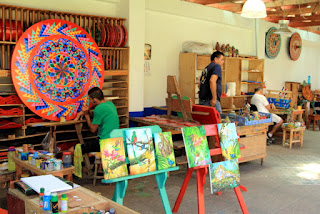We finally arrived in the small rural village of Sarchi that is famous for the Fabrica de Carretas where they make and paint oxcarts. Painting oxcarts with intricate and vivid designs is almost a lost tradition, so the factory tries to keep the tradition alive by employing artist who paint and decorate oxcarts with traditional styles and patterns. The factory tour was interesting and it was almost like stepping back in time a hundred years. Even though they have electricity on the site, the factory is located adjacent to a stream and the workers use a waterwheel to power their cutting and shaping tools.
While we were at the factory, several artist were at work painting various wheels and carts. After the tour, we were treated to a nice buffet of fresh fruit, which really hit the spot!
On the way out of town, we drove by the Church of Sarchi and the "World's Largest Oxcart." Unfortunately, because we were behind schedule, the bus driver announced that we did not have time to stop for pictures; so we had to do the best we could through the bus windows. (That is why I hate bus tours! There were several women on the tour that stayed in the oxcart gift shop for an extra 30 minutes while the rest of us waited for them on the bus!)
Just up the road from Sarchi is the community of Grecia and the famous "Iron Church." People often ask why the citizens of Grecia built a metal church using pre-fabricated red steel plates instead of using traditional wood or brick for building materials. Our guide explained that the first church built on the site was made of wood, but it caught fire and burned down. A second wood church was built on the site, but it also burned down. Since wood did not seem to be the ideal construction material, a third church was built on the site using brick and adobe; but it was totally destroyed by a strong earthquake. Not to give up easily, the community then hired a company in Belgium to fabricate a metal church, which is still standing today. (Unfortunately we did not have time to stop for pictures!)
 |
| Photographer Unknown |
In San Jose (Capital City) we drove past the Parish Church of Costa Rica and then we toured the National Museum.
The museum was original built as a fortress in 1917 and occupied as a military barracks until the civil war in 1948. During the war, the building sustained substantial shelling and the tower at the corner of the building is still severely pock-marked with bullet holes. In 1950 the fortress was converted to the National Museum.
While on this trip we had an amazing tour guide that was a walking-talking encyclopedia for facts and figures and while in the museum he gave an excellent discussion on the early history of Costa Rica. Throughout the museum grounds is a collection of stone spheres that are thought to date back to 300-800 AD. No one really knows what the stones were used for, but the spheres are attributed to the extinct Diquis Culture and are sometimes referred to as Diquis Spheres.
Last stop of the day was at the National Theater, which is considered to be the most beautiful building in Costa Rica.
Construction on the Theatre started in 1891, but was delayed due to construction design problems. Finally, an Italian engineer was brought in to correct the problems and he finish the building in 1897. The interior of the building contains lavish furnishings and features extensive use of gold trim. Today, the Theatre is home of the Costa Rica National Symphonic Orchestra.
On the way back to the ship, we ran into several traffic jams, and I nervously kept checking my watch to see if we would make it on time. Fortunately, we made it back to the ship with about 30 minutes to spare before the Captain pulled up the anchor and headed out to sea!

































No comments:
Post a Comment